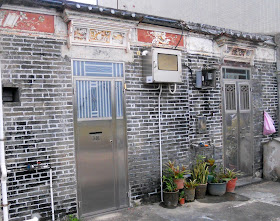Of course, there are unanswered questions that I intend to pursue if possible. To begin with, the first building I’ve described seems to be rather grand to be merely a row of village houses (it has two storeys for a start). And does the existence of the watchtower indicate that this village was once more important than others in the area? If I can find answers to these puzzles, I will post a report.Two months after my initial visit, I returned to this location to show Paula what I’d discovered here. I took more photos of the friezes over the doorways and the mouldings between the doors, but they weren’t as good as the ones I’d taken originally, so if you want to take a closer look at the decorative features of this building, then the photos in the original report are the best I can do. This is a general view:
The three doorways are effectively barred, but there is a door in the back of the building that provides an entry to the left-hand house. When we investigated, we found that this door is kept closed by a crude bolt, but it isn’t locked. The first photo, of a small window in the rear of the building, provides a reason for Paula’s belief that this was once a prison, but bars on windows were a common security feature of older village houses:
When we entered, we were surprised to find that old agricultural machinery was being stored here:
Other points of interest include the bars that can be slid into place to reinforce the main door, which I would describe as a kind of horizontal portcullis:
All the floors/ceilings have been removed, so it’s possible to see the roof beams from ground level:
And this is a moulding above one of the internal doors:
A few weeks before I left Hong Kong, I heard the history of this ‘rather grand’ building. Apparently, the patriarch of the Pang clan, whose village this is, swore that he would never sell any village land. Unfortunately, his daughter, the youngest of fifteen children, disobeyed her father and sold the land on which this building stands to a developer. The old man was furious and blockaded the site so that it couldn’t be occupied. So, despite its grandeur, this building has never been occupied. What a waste!





















